| Ken Sakamura |
 |
|
 |
 |
 |
|
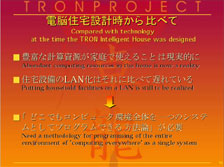
Slide 19
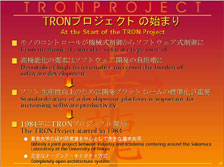
Slide 20
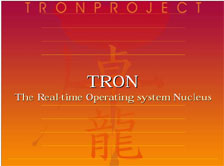
Slide 21
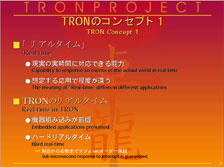
Slide 22
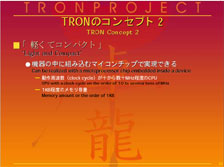
Slide 23
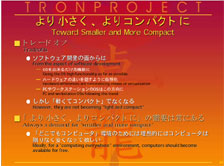
Slide 24
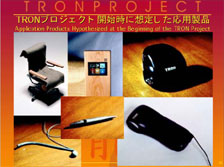
Slide 25 |
Slide
19 - Compared with technology at the time the TRON Intelligent House
was designed
The TRON Intelligent House's system was created based not on computers of the time, but envisioning future one-chip microcontroller functionality. For this reason, in most cases workstations and PCs were used in place of microcontrollers, turning the home's basement into a huge computer center. We were told that there was no way that such power information processing capabilities could be used in a single home, but as if in answer to my predictions, today the performance and cost of microprocessors have made it possible to exceed those capabilities. In contrast, however, the networking of home systems has lagged behind this progress. This biggest reason for this is the lack of what I just mentioned: a methodology to allow the Computing Everywhere environment as a whole to be programmed like a single system.
From the start, TRON has been involved in preparing the component side of the concept, but at the same time it has also always been involved in researching this programming methodology. I would like to finish this research over the next few years, realizing the goals of the TRON project.
Incidentally, we had people actually live in the TRON Intelligent House for 3 years. We gathered a great deal of data, and researched cooperative and compromise-based operation. We also experimented with possible emergency situations, including computer failure, fire, and intruders. Unfortunately, at the end of the experiment, the TRON Intelligent House was torn down in order to allow the land to be used for another purpose.
In this way, the TRON project is determined to build an architecture that can be used as widely and for as long as possible, by solidifying our image of the future, and getting feedback on our concept.
Slide 20 - At the Start of the TRON Project
TRON predicts that the future will bring huge changes to the concept of skilled engineering, where mechanical control gives way to software control.
Naturally, the bulk of development will become software development. It will increasingly be the job of software development to improve functionality. Improving software productivity will be the key to shortening development cycles and maintaining quality - and this hypothesis is already becoming reality.
In the early 1980s, I was already involved in researching operating systems for embedded applications, thinking that it was vital to standardize a development platform in order to increase software productivity. In the three years from 1981 to 1984 I drew up requirement specifications, then in 1984 started the TRON project in order to give them form.
Slide 21 - The Real-time Operating System Nucleus
TRON stands for The Real-time Operating system Nucleus. A computer embedded in a machine must operate in real time. This includes the meaning of developing a standard platform for embedded real-time operating systems.
The TRON project is a cooperative effort between industry and academia. My laboratory at the University of Tokyo serves as the project's core, and includes participants from microelectronics and microprocessor user firms. The project is being pursued with a completely open architecture.
Slide 22 - TRON Concept 1
The number-one concept of TRON is "real-time" - only natural, since it is part of the TRON name. As the name implies, the term "real time" entails the ability to act in actual time. A device operated by a person must respond to that person's operations without delay, and an automotive engine control system has got to respond to fuel-combustion status incredibly quickly. The real-time performance demanded by each system is different, but in cases like engine control, response times of less than a thousandth of a second are required, with an explosion hanging in the balance. No matter what the processing load, the system must never fail to respond to a request for which a result absolutely must be returned within a given time. This field is called "hard" real time; naturally, since TRON is predicated on embedding, it must be able to handle this field as well.
In contrast, the focus on the purposes and performance of PC and workstation OSs is different, and so naturally there is not such a strict demand for real-time performance. Since the computer is responding to a person, it is generally all right for response performance to be much lower. In the worst case, you can always just show the user an hourglass symbol and have them wait. For example, for ITRON, the real-time response from interrupt to response must be under a microsecond - a millionth of a second. But for ordinary PC and workstation OSs, response times are from a few milliseconds to a few dozen milliseconds. In other words, about a thousand to 10,000 times slower.
Slide 23 - TRON Concept 2
Another concept is "lightness and compactness." The only way to achieve "hard" real time is by embedding a microchip in the device. That means that it must be achieved with CPU performance and memory that are far inferior to those of a PC. For instance, the CPU has to operate at a clock cycle of about 10 to 40 MHz, with a system capacity of about 1 KB. That is probably about one five-hundredth the power of one of today's PCs.
Slide 24 - Toward Smaller and More Compact
The trade-off in this area is one of the more difficult points of architecture design. From the standpoint of software development, OS performance should be maximized, while hardware differences hidden (this is called virtualization). But if we do this, how can we make the computer lightweight and compact? This differs from the trend among PC and workstation OSs, which are growing ever richer and more virtualized, in order to eliminate the burden of developing highly functional, complex applications.
My feeling after working on TRON for many years, is that no matter how far you progress, there will always be demand for smaller, more compact products. If you come up with a technology that has twice the performance for the same cost, next they will want the same performance at half the cost. The ideal of the Computing Everywhere environment is to get computers as cheap as possible. After all, think about extreme cases like my earlier example of putting chips in trash.
Slide 25 - Electronic Writing Implements
If you divide TRON into a system family of a small subset and a full version, generally the small subset will be more popular. When you are putting things into these tiny devices, "small" becomes a kind of mantra. This is where the TRON concept differs most sharply from the "big guns" approach of PC OSs, which have grown into huge behemoths. I feel that this difference stems from the target image that was created when TRON was first begun.
|
|
|